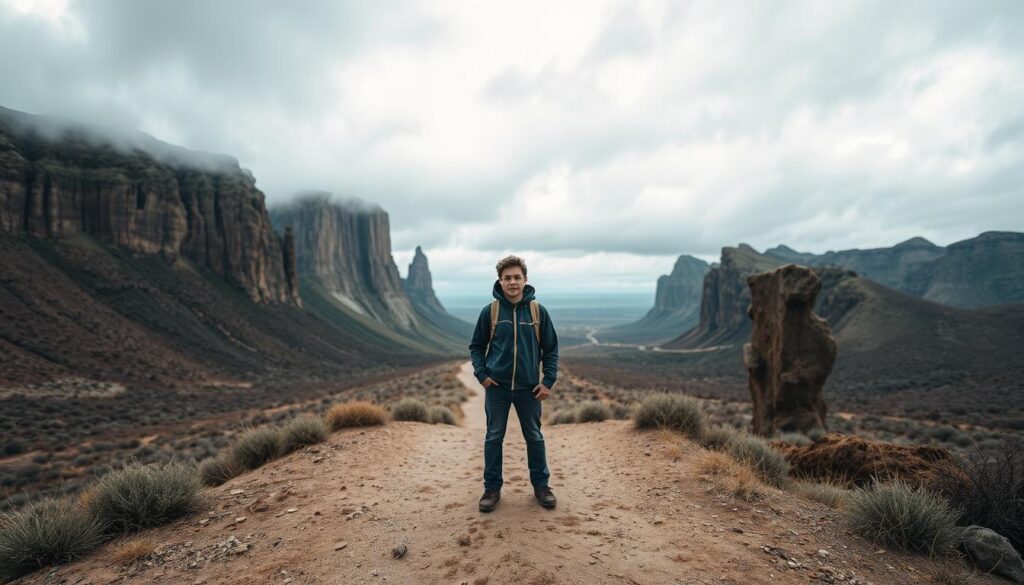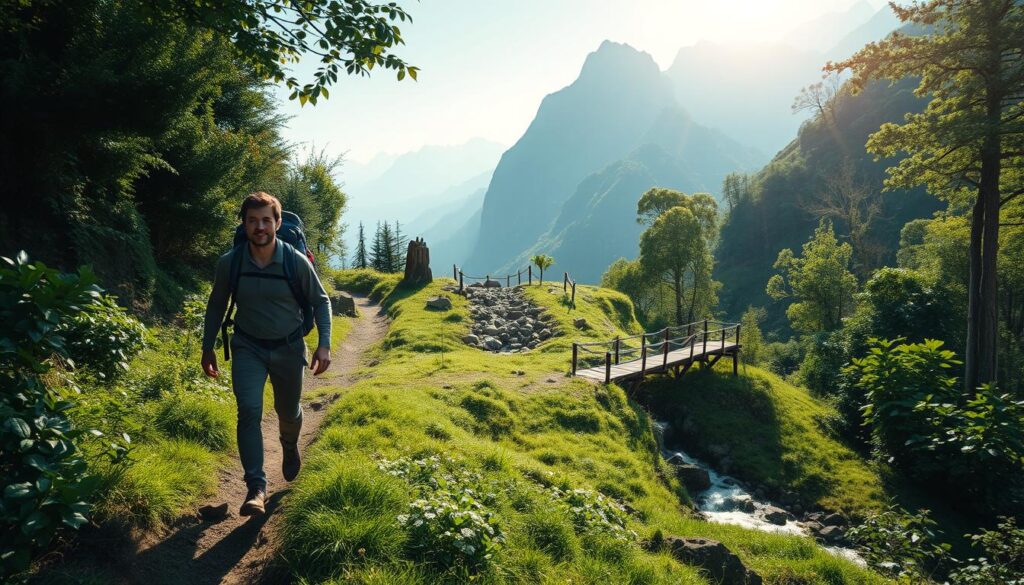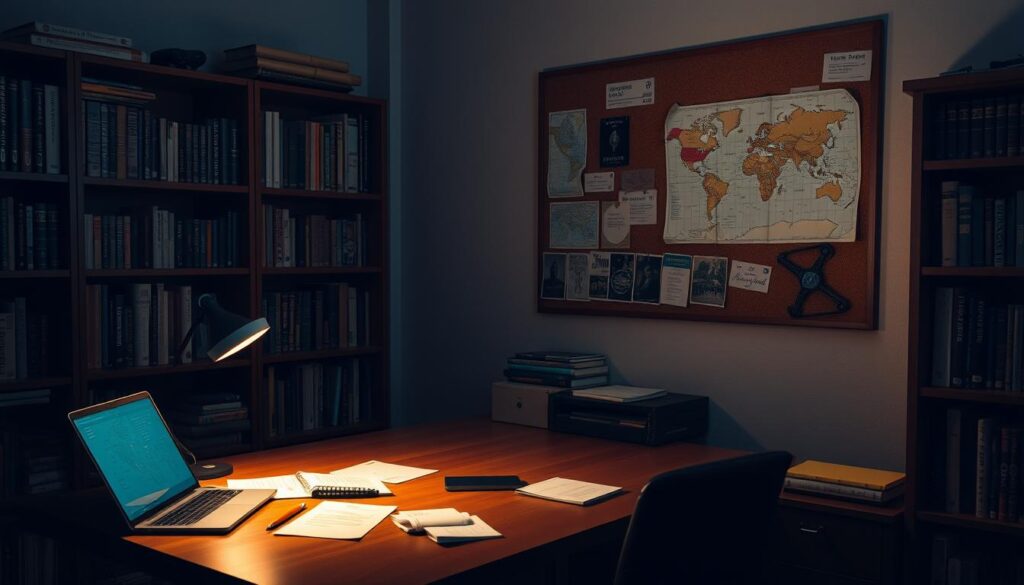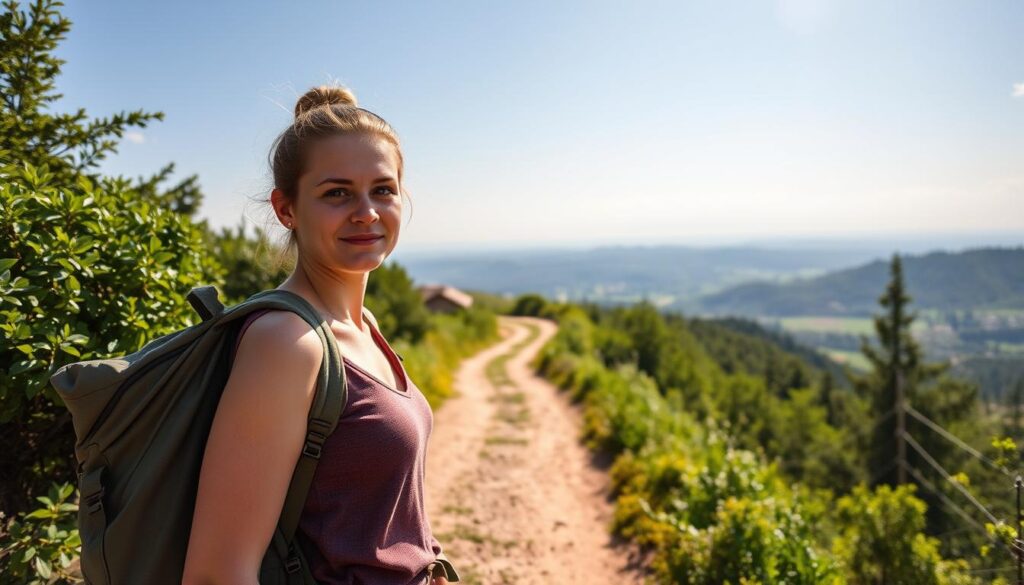How to Overcome Fear of Solo Travel
Did you know 65% of Americans admit feeling nervous about traveling alone? Yet over 80% who try it describe the experience as transformative. Even globetrotters with stamps from 30+ countries confess to pre-trip butterflies – proof anxiety doesn’t disappear, but confidence grows.
This guide isn’t about eliminating nerves. It’s about using them as fuel. Millions now choose independent journeys, with solo bookings up 45% since 2020. Why? Because navigating new cities alone builds problem-solving skills faster than any corporate training.
You’ll discover practical ways to reframe uncertainty as excitement. Learn how seasoned travelers prepare mentally, pack strategically, and connect authentically. We’ll explore gradual exposure techniques – weekend getaways before month-long expeditions.
By the end, you’ll have tools to transform apprehension into anticipation. Imagine swapping “What if I get lost?” for “I’ll discover hidden cafes.” Picture swapping “Who will I talk to?” for “I’ll collect stories from five continents.”
Key Takeaways
- Pre-trip nerves affect 3 in 5 travelers but fade with experience
- Solo trips boost decision-making skills and self-reliance
- Strategic planning reduces stress while allowing spontaneity
- Small-group tours ease beginners into independent travel
- Digital nomad communities provide instant support networks
Fear of Solo Travel: Understanding Your Anxiety

Exploring new places alone sparks excitement but also brings hidden worries to the surface. Let’s unpack what makes solo adventures feel daunting and why these feelings are more common than you think.
Defining the Fear
Solo travel anxiety isn’t just about safety. It mixes practical concerns like navigating foreign transit systems with emotional ones – wondering if you’ll make friends or eat dinner alone. Many travelers describe it as wearing a backpack filled with “what-ifs.”
Our brains evolved to see unfamiliar situations as threats. A 2023 psychology study found that 68% of first-time solo travelers initially perceive crowds and language barriers as dangers rather than adventures. This instinct kept ancestors safe but can limit modern exploration.
Why It Happens and Who It Affects
Safety tops the worry list. People often assume being alone makes them targets, though crime statistics show group travelers face similar risks. Introverts face a double challenge: wanting meaningful connections but dreading forced small talk with strangers.
Unexpectedly, travel anxiety affects seasoned globetrotters too. Planning every detail alone – from missed flights to dietary needs – creates mental fatigue. As one traveler shared: “Carrying all the responsibility feels like solving a puzzle blindfolded.”
Yet these concerns unite rather than divide. College students, retirees, and digital nomads all report pre-trip nerves. Recognizing this universality helps transform anxiety from a personal flaw into a shared human experience.
Embracing the Solo Travel Mindset

Traveling without companions lets you rewrite the rules of exploration. Many discover that stepping away from familiar faces creates unexpected opportunities for connection and self-trust.
Changing Your Perspective on Solitude
Being traveling alone doesn’t mean isolation. Hostel common areas and local cafes buzz with others seeking meaningful exchanges. A recent survey found 74% of independent adventurers made new friends faster than when vacationing with groups.
Consider this comparison of group versus solo experiences:
| Aspect | Group Travel | Solo Experience |
|---|---|---|
| Social Interactions | Limited to existing companions | Open to meeting diverse people |
| Decision Making | Compromise required | Complete personal freedom |
| Spontaneity | Group coordination needed | Instant itinerary changes |
Seasoned explorers often report feeling more connected when journeying independently. Without group dynamics, you become approachable to locals and fellow wanderers. One backpacker shared: “My best memories started with ‘Mind if I join you?’ at a street food stall.”
This way of exploring builds comfort in your own company while creating space for authentic moments. You’ll find that making choices based solely on your interests leads to richer, more personal discoveries.
Taking Baby Steps to Build Confidence

Building travel independence works like muscle memory – small repetitions create lasting strength. Start with neighborhood experiments before tackling cross-country journeys. Local coffee shops make perfect training grounds for first solo experiences.
Neighborhood Adventures First
Try these low-stakes activities to expand your comfort zone:
- Watch sunset at your city’s best viewpoint alone
- Order dinner at the bar counter instead of takeout
- Visit museums using audio guides instead of group tours
One hiker shared: “Eating pancakes alone felt awkward at first. Now I chat with chefs about regional maple syrup varieties.”
Short Journeys, Big Wins
Compare local and regional solo trip options:
| Activity | Local Trial | Weekend Version |
|---|---|---|
| Navigation Practice | Bus to new district | Train to nearby state park |
| Social Exposure | Bookstore reading event | Farmers’ market in next county |
| Decision Making | Choose lunch spot | Plan 2-day itinerary |
Group tours blend independence with built-in companions. Many first time travelers find structured adventures ease them into managing logistics while providing social safety nets.
Track progress in a journal. Note how each trip – whether to the library or lakeside cabin – adds tools to your travel toolkit. These documented wins become motivation for future journeys.
Building a Research-Backed Travel Plan

Smart preparation turns jitters into excitement. A well-researched itinerary acts like a safety net, letting you explore freely while knowing you’ve covered essentials. Let’s break down how to gather intel that empowers rather than overwhelms.
Choosing Safe Destinations
Not all locations suit first-time explorers equally. Compare these options based on key factors:
| Destination | Safety Rating | Language Accessibility | Tourism Infrastructure |
|---|---|---|---|
| Iceland | 9.8/10 | English widely spoken | Excellent transportation |
| Japan | 9.5/10 | Basic English common | Efficient rail network |
| India | 6.2/10 | Regional dialects vary | Mixed reliability |
Focus on countries with clear signage and reliable emergency services. Many hostels now offer female-only dorms and 24/7 security checks. Always cross-reference government travel advisories with recent visitor reviews.
Learning Local Customs and Language Basics
Mastering five key phrases builds bridges faster than any app. In Thailand, a simple “sawasdee krub/ka” (hello) shows respect. Research dining etiquette – some cultures consider left-handed eating rude, while others prize slow meal pacing.
One backpacker shared: “Learning ‘Where’s the bathroom?’ in six languages became my party trick – and lifesaver!” Free language apps like Duolingo make practicing fun during commute times.
Document your findings in a digital folder. Include maps of safe neighborhoods, emergency contact numbers, and backup accommodation options. This prep work lets you swap stress for spontaneous detours when adventure calls.
Addressing Social and Safety Concerns

Why do solo explorers often return home with unexpected friendships? Navigating social perceptions and physical risks requires equal attention. Let’s tackle both aspects to help you feel empowered on the road.
Overcoming Loneliness and Negative Judgments
Family members might question your plans, but their concerns often reflect their own worries about unfamiliar experiences. A seasoned backpacker shared: “My mom thought I’d be kidnapped. Now she brags about my Instagram photos from Bali.”
Connect with people who get it. Online groups like The Solo Female Traveler Network offer real-time advice and encouragement. Members share everything from hostel reviews to strategies for dining alone confidently.
Practical Safety Tips for Traveling Alone
Smart preparation minimizes risks without limiting adventure. Compare these essential and advanced safety measures:
| Category | Essential Tips | Advanced Strategies |
|---|---|---|
| Communication | Share itinerary daily | Use encrypted location apps |
| Emergency Prep | Save local police number | Learn “Help!” in local language |
| Navigation | Carry paper maps | Download offline transit apps |
Trust your instincts – if a situation feels off, leave immediately. Many solo travelers practice “resting alert face” in mirrors to appear approachable yet aware. Pack a doorstop alarm for hotel rooms and always keep emergency cash separate from your wallet.
Remember: Traveling alone becomes safer when you blend caution with curiosity. As one adventurer noted: “My safety checklist takes 10 minutes – the freedom it creates lasts all day.”
Mindfulness Techniques and Anxiety Management

Mental preparation can be your secret weapon against overwhelming moments abroad. Like packing a first-aid kit for emotions, these strategies help you navigate unexpected challenges while staying grounded in new environments.
Breathing Exercises and Meditation
Try the 4-7-8 technique: inhale for 4 counts, hold for 7, exhale for 8. This Navy SEAL-approved method calms racing thoughts during chaotic moments like missed connections. Free apps like Headspace offer guided meditations specifically for travel anxiety.
| Technique | Purpose | Duration |
|---|---|---|
| Box Breathing | Reduce panic attacks | 3 minutes |
| Guided Visualization | Enhance focus | 10 minutes |
| Body Scan | Release tension | 15 minutes |
One backpacker shared: “Meditating at train stations became my superpower. It turned delays into recharge time.” Start practicing weeks before departure to build muscle memory for stress management.
Positive Affirmations to Reframe Fear
Create mantras that address specific worries. If language barriers stress you, try: “I communicate through kindness and gestures.” Write these on hotel stationery or set them as phone reminders.
| Situation | Negative Thought | Empowering Affirmation |
|---|---|---|
| Eating Alone | “People are judging me” | “I’m savoring local flavors mindfully” |
| Getting Lost | “I’ll never find my way” | “Every detour reveals hidden gems” |
Pair affirmations with a gratitude journal. Each evening, note three things that went well. This practice rewires your brain to focus on victories rather than anxiety triggers. Over time, you’ll build natural comfort in handling uncertainties.
Crafting a Flexible Itinerary for Your Journey
Crafting the perfect travel plan is like packing a suitcase – leave room for surprises. A balanced itinerary acts as your safety net, letting you wander freely while knowing essentials are covered. Start by booking key elements: flights, lodgings, and intercity transport. This foundation eliminates logistical stress, freeing mental space for authentic experiences.
Planning Daily Activities without Over-Scheduling
Structure mornings around one or two must-see spots, then let afternoons breathe. A food tour in Rome’s Trastevere district might lead to an impromptu pottery class – that’s where magic happens. As seasoned explorer Lena Cruz notes: “My Pinterest board had 50 pinned cafes. I visited three and found my favorite spot through a local’s tip.”
Consider this approach for your first solo trip:
- Map key attractions but skip rigid time slots
- Bookmark alternative activities in each neighborhood
- Schedule recharge hours like midday swims or journaling
Digital tools transform chaos into clarity. Use apps to save walking routes between landmarks, or share real-time updates with loved ones. Build buffer time between activities – that “wasted” hour often becomes your favorite memory. Remember: plans change, but preparation empowers you to pivot gracefully.
Learning from Experienced Solo Travelers
Seasoned explorers hold treasure maps to confidence-building strategies you won’t find in guidebooks. Their stories reveal how first solo trips transform into life-changing adventures through practical wisdom and community support.
Real Stories and Lessons Learned
Sarah, a former accountant, describes her career-break journey: “Quitting my job felt like jumping off a cliff. But landing in Lisbon alone taught me I could rebuild my wings mid-air.” Her blog details navigating language barriers and finding friends through cooking classes.
Compare common challenges and solutions from veteran travelers:
| Challenge | Community Solution | Outcome |
|---|---|---|
| Getting Lost | Local WhatsApp groups | Instant directions + café tips |
| Dining Alone | Food tour meetups | Shared meals, new contacts |
| Budget Planning | Cost-tracking templates | Stress-free spending |
Online Communities and Support Groups
Digital hubs connect wanderers across time zones. Top resources include:
- Nomad Soulmates Facebook group (235k members)
- r/solotravel subreddit’s crisis management guides
- Hostelworld’s “Travel Buddies” feature
One backpacker shared: “The Solo Travel Society helped me find a hiking partner in Peru within 24 hours.” Many groups offer mentorship programs pairing new explorers with veterans who’ve navigated similar routes.
Turning Fear into a Catalyst for Growth
What if your greatest anxieties could become your superpowers? Pushing boundaries through adventure reshapes how you interact with the world. Like strengthening a muscle, each challenge builds mental resilience that spills into daily life.
Personal Development Through Adventure
Navigating foreign markets or deciphering subway maps does more than get you from point A to B. These moments train your brain to solve problems creatively. “After getting lost in Marrakech’s medina, negotiating my startup deals felt easy,” shares frequent explorer Priya Kapoor.
Stepping outside your comfort zone reveals hidden strengths. You might discover:
- Patience during delayed flights transfers to workplace conflicts
- Budgeting skills from hostels help manage home finances
- Cultural adaptability becomes a career asset
View discomfort as your growth playground. That awkward dinner alone? It’s practice for speaking up in meetings. Missed trains teach graceful pivoting – a skill that’s golden in parenting or entrepreneurship.
The world becomes your classroom when you embrace experiences that stretch you. You’ll return home not just with photos, but with proof that adventure reshapes what you believe is possible.
Conclusion
Your passport holds more than stamps—it’s a mirror reflecting untapped courage. Those initial jitters about traveling alone often transform into proud stories shared over coffee. Remember, even seasoned explorers felt unsure before their first solo trip.
Every journey teaches something new. You might master subway systems in Tokyo or discover sunrise views better than any guidebook photo. These moments add up, building confidence that spills into daily life back home.
Ready to start? Pick a destination that excites you, pack light, and trust your instincts. The world rewards those who dare to explore it independently. Your greatest adventure begins where routine ends.
FAQ
How do I start traveling alone if I’m nervous?
What if I feel lonely during my first solo trip?
How can I stay safe while traveling alone?
What destinations are best for first-time solo travelers?
How do I handle language barriers alone?
Will people judge me for traveling solo?
How can I manage anxiety during flights or transit?
Should I plan every detail or leave room for spontaneity?
Are online travel communities helpful for beginners?
Can solo travel really help personal growth?

Adam Peter is a finance, travel, and automotive writer with over a decade of experience. He creates clear, practical content to help readers manage their money, explore the world with confidence, and make informed decisions about cars and travel gear. His work blends expert insight with real-world usefulness.




